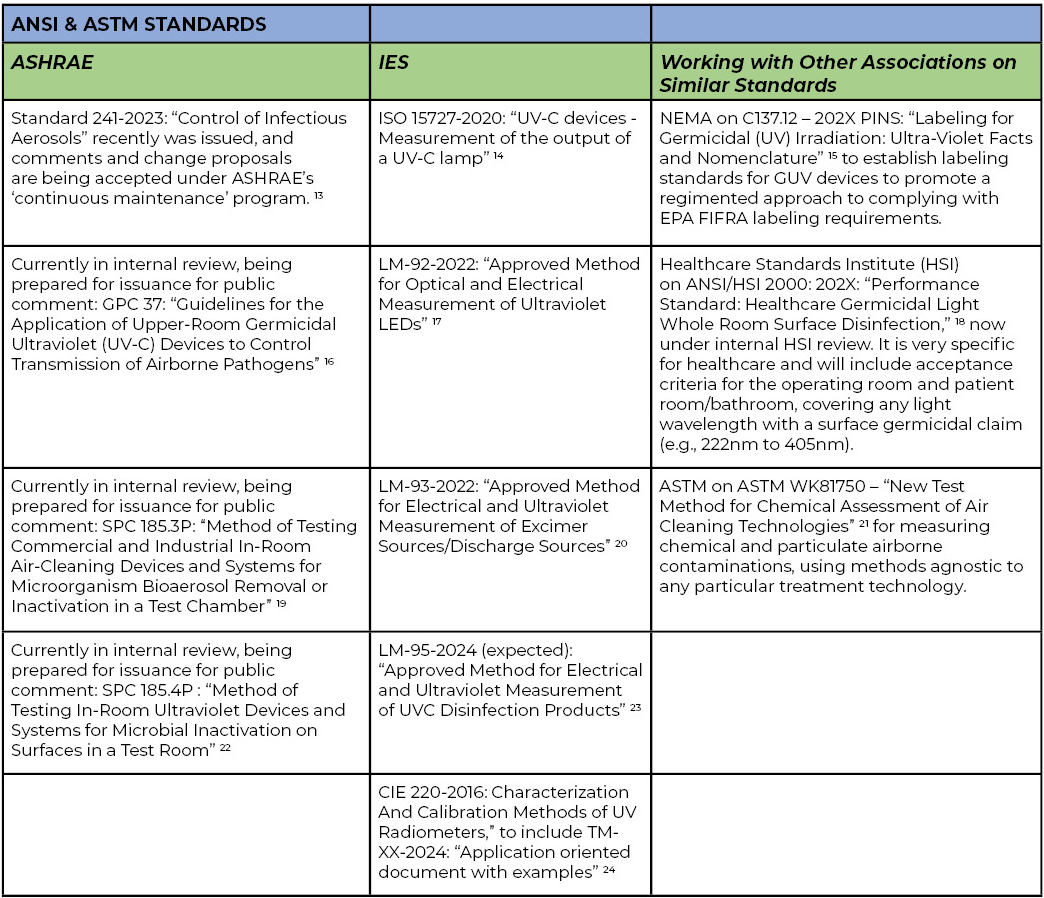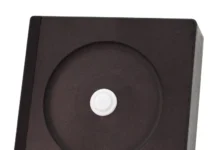With all the new developments in the industry, it sure feels like GUV technologies and the related issues are evolving at Einstein’s cosmological constant, c – aka, the speed of light (pun intended). This makes it harder to keep up with cutting-edge developments and makes communication all the more critical. Once we start communicating, we need to collaborate, consolidate and educate if we’re to make any impact on preventing the next pandemic. Communicate, Collaborate, Consolidate and Educate – C3E.
The importance of this really came home to me recently, when I almost stove-piped myself (i.e., I was sure I knew the answers). In routine conversations with trusted GUV colleagues, I was realigned when they shared the following:
- NIOSH regulatory guidance 1 on formaldehyde exposure and other airborne toxins, a key data point in recent discussions on secondary bi-products from using 222nm GUV technologies.
- EPA had endorsed using surrogate pathogens in product testing for efficacy against SARS-CoV-2 and other similar airborne viruses 2 (as opposed to testing against each named pathogen, separately, as normally required by EPA under FIFRA).
EPA’s change of heart is a potential game-changer regarding testing and labeling GUV devices. Both may radically change how we address these issues and several related topics going forward – and, they came up unexpectedly in casual conversation. Similarly, a dear personal friend mentioned the recent CBS 60 Minutes’ IAQ feature 3, which opened up several new collaboration leads. All of these were very serendipitous and helpful.
So, in an effort to return the favor, this column will communicate the multiple opportunities out there for C3E in the GUV sector, sharing who is doing what, where, why and how to promote future pandemic prevention. Readers are invited to join in.
Initiatives in GUV-related associations and universities include the following:
- NALMCO, recognizing that GUV is an effective method for disinfection of air and surfaces, has developed a training and certification program that will serve as the first step toward educating the public on the proper and safe use of Germicidal UV-C. 4
- AIHA Indoor Air Quality Task Force presents the key role OEHS professionals provide in promoting healthy IAQ. 5
- Dr. Kathleen McPhaul’s project on “…A blueprint for communication with the public about GUV,” 6 as presented at ICFUST in June 2023.
Related Federal IAC initiatives include the following:
- Quarterly EPA IAQ webinars 7 put on by EPA’s Indoor Air Quality Program
- Federal Interagency Committee on Indoor Air Quality 8, chaired by EPA
- White House Summit on Indoor Air Quality 9 and the associated “Clean Air in Buildings Challenge” 10
- GSA’s “Green Buildings” 11 and DOE’s “Energy Efficiency: Buildings and
Industry” 12 programs, which are exploring innovative ways to improve IAQ through demonstration projects
Opportunities for collaboration abound in GUV industry efforts and initiatives, and there are multiple opportunities to submit comments and input into GUV-related ANSI standards now being enhanced, reviewed and finalized, prior to formal release as approved voluntary industry consensus standards, acceptable for incorporation into Federal regulations and procurements (Table 1).

Then, there’s consolidation and education, where you can not only help develop the product, but also deliver it, refine it and make it real. In IUVA, members are working on several GUV related initiatives where this could happen. Consolidated education efforts include the following:
- From the “GUV in Public Spaces” Workshop, 25 held in June 2023 in Atlanta:
- the Education and Communication Task, 26 led by Dan Spicer
- the Regulatory & Governance Task, 27 led by Dianne Poster, and
- the Industry Technology Task, 28 led by Ashish Mathur
- Under the auspices of IUVA’s Education Task Force, efforts are underway to develop a UV Education Resource Center website 29 (to include Research and Regulatory Repositories), led by Phyllis Posy. It is intended to “develop a broad-based archive and knowledge base of educational and resource materials about UV light and its applications.”
- As part of the work done by the Technology and Research of Air and Surface Treatment (TRAST) task force, a new project has been initiated to explore the various factors which impact the “Measurement of Intrinsic Kinetics of Air Disinfection,” 30 led by Ted Mao.
All of these are evolving and morphing as rapidly as SARS-CoV-2. If you want to make your mark, contribute to the GUV program and start helping to save lives, sign up and join in. Have no doubt, the next pandemic is coming. So, for us, it’s still all about saving lives… Many thanks for your support.
References
- NIOSH, “NIOSH Pocket Guide to Chemical Hazards,” Formaldehyde, website last reviewed 30 October 2019 (https://www.cdc.gov/niosh/npg/npgd0293.html )
- EPA, “EPA Registers Air Sanitizer for Residential and Commercial Use Against Influenza and Coronavirus,” website notice released 6 October 2022, last updated 2 May 2023 (https://www.epa.gov/pesticides/epa-registers-air-sanitizer-residential-and-commercial-use-against-influenza-and )
- CBS 60 Minutes, 30 October, (https://www.youtube.com/watch?v=WxEssOeEsVk)
- NALMCO, Germicidal Ultraviolet Training, 2023 (https://www.nalmco.org/guv-training)
- AIHA, AIHA/ASHRAE IAQ Task Force, recently formed, meeting schedule TBD
- Dr. K. McPhaul, University of Maryland, at First International Congress on Far-UVC Science & Technology, (ICFUST), June 14-16, 2023 (https://www.youtube.com/watch?v=uRsU7ZEL9NI)
- EPA, “Indoor Air Quality Science and Technology – Webinar Series” (https://www.epa.gov/indoor-air-quality-iaq/indoor-air-quality-science-and-technology )
- EPA, “Federal Interagency Committee on Indoor Air Quality,” ongoing, (https://www.epa.gov/indoor-air-quality-iaq/federal-interagency-committee-indoor-air-quality )
- White House, White House Summit on Indoor Air Quality, Oct 11, 2022 (https://www.youtube.com/watch?v=IoPzKsV-Kyo )
- White House, “Clean Air in Buildings Challenge” (https://www.whitehouse.gov/cleanindoorair/ )
- GSA, “Federal High-Performance Green Buildings” (https://www.gsa.gov/governmentwide-initiatives/federal-highperformance-green-buildings )
- DOE, “Energy Efficiency: Buildings and Industry,” (https://www.energy.gov/eere/energy-efficiency-buildings-and-industry)
- ASHRAE, “ASHRAE 241-2023: Control of Infectious Aerosols” (https://www.techstreet.com/ashrae/standards/ashrae-241-2023?product_id=2567398#amendments )
- ISO, ISO 15727-2020: “UV-C devices – Measurement of the output of a UV-C lamp” (https://www.iso.org/standard/67815.html)
- NEMA, “C137.2 – 202X PINS – Labeling for Germicidal (UV) Irradiation: Ultra-Violet Facts and Nomenclature,” as submitted for consideration in accordance with NEMA’s ANSI standards protocols
- ASHRAE, “GPC-37P: Proposed Guidelines for the Application of Upper-Air (Upper Room) Ultraviolet Germicidal (UV-C) Devices to Control the Transmission of Airborne Pathogens (https://www.ashrae.org/technical-resources/standards-and-guidelines/titles-purposes-and-scopes )
- IES, ANSI/IES/IUVA LM-92-22 – “Approved Method: Optical and Electrical Measurement of Ultraviolet LEDs,” (https://store.ies.org/product/lm-92-22-approved-method-optical-and-electrical-measurement-of-ultraviolet-leds/?v=7516fd43adaa )
- A. Kreitenberg, Healthcare Standards Institute, “ANSI/HSI 2000: 202X: “Performance Standard: Healthcare Germicidal Light Whole Room Surface Disinfection,” now under HIS review
- ASHRAE, SPC 185.3P “Method of Testing Commercial and Industrial In-Room Air-Cleaning Devices and Systems for Microorganism Bioaerosol Removal or Inactivation in a Test Chamber” (https://www.ashrae.org/technical-resources/standards-and-guidelines/titles-purposes-and-scopes#spc185-3p )
- IES, ANSI/IES/IUVA LM-93-22 – “Approved Method: Optical and Electrical Measurements of Far UV-C Excimer Sources (https://store.ies.org/product/lm-93-22-optical-and-electrical-measurements-of-far-uv-c-excimer-sources/?v=7516fd43adaa )
- ASTM, ASTM WK81750 – “New Test Method for Chemical Assessment of Air Cleaning Technologies” (https://www.astm.org/workitem-wk81750 )
- ASHRAE, SPC I85.4P “Method of Testing In-Room Ultraviolet Devices and Systems for Microbial Inactivation on Surfaces in a Test Room (https://www.ashrae.org/technical-resources/standards-and-guidelines/titles-purposes-and-scopes#standard1854p )
- IES, ANSI/IES/IUVA LM-95-2024 (expected) – “Approved Method for Electrical and Ultraviolet Measurement of UVC Disinfection Products,” under internal development
- CIE 220:2016 “Characterization and Calibration Methods of UV Radiometers”, ISBN: 978-3-902842-07-7 (https://cie.co.at/publications/characterization-and-calibration-methods-uv-radiometers )
- T. Cowan, “Achieving Consensus on GUV in Public Spaces Workshop Earns “Wow” Response,” UV Solutions, 2023 Qtr 3, pgs. 22-24 (https://bluetoad.com/publication/?i=802260 )
- Ibid
- Ibid
- Ibid
- UV Education Resource Center (https://iuvaeducationresourcecenter.org/ )
- T. Mao, minutes of Technology and Research of Air and Surface Treatment (TRAST) Conference Call, 17 October 2023





